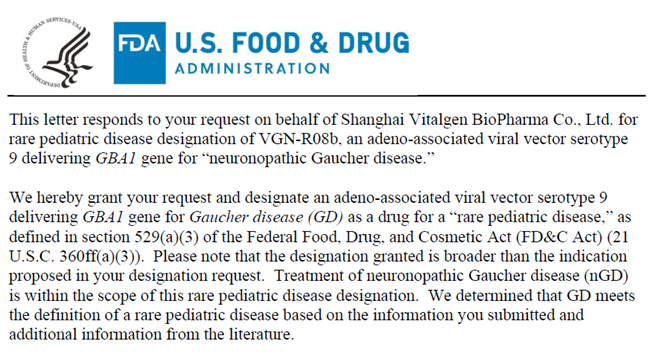On October 21, 2022 (EDT), Shanghai Vitalgen BioPharma Co., Ltd. was granted the Rare Pediatric Disease Designation (RPDD) for the treatment of Neuronopathic Gaucher Disease (nGD) by the U.S. Food and Drug Administration (FDA) for its independently developed VGN-R08b. This product is our second gene therapy product to obtain FDA RPDD after VGM-R02b for the treatment of Glutaric Acidemia Type I received FDA RPDD in May 2022, and will have the opportunity to apply for U.S. Pediatric Orphan Drug Priority Review Voucher (PRV) as a rare pediatric disease product.

Introduction of nGD:
Ghoshay disease (GD) is an autosomal recessive disorder caused by mutations in the glucocerebrosidase gene (GBA1) resulting in a deficiency in lysosomal glucocerebrosidase (Gcase) activity, causing accumulation of its substrate glucocerebroside in the lysosomes of mononuclear macrophages in the liver, spleen, bone marrow and central nervous system, ultimately leading to multi-organ dysfunction. According to whether the nervous system is involved, GD is divided into peripheral lesion type and neuronopathic type, of which the clinical manifestations of neuropathic Gaucher Disease (nGD) include acute and chronic neurological involvement in addition to enlargement of spleen or liver, anemia and thrombocytopenia, with the clinical manifestations mainly being dysplasia, spasticity, epilepsy, ocular motility disorders and ataxia with developmental delay. The acute neuropathic Gaucher Disease occurs mainly in the neonatal to infant period, with a rapid progression and high mortality rate; the chronic neuropathic Gaucher Disease often develops in childhood.
Introduction of VGN-R08b:
VGN-R08b is a gene replacement therapy using AAV9 as a vector, which is administered by intracerebral injection to backfill the gene containing functional human GBA1, and the backfilled GBA1 will produce GCase back into the lysosomes and replace the mutated endogenous GCase to restore its activity, thereby preventing the progression of functional disorders of the central nervous system due to the lack of GCase activity in infancy and childhood.
In addition, mutations in the GBA1 gene are also the most common genetic risk factor for Parkinson's disease, and the loss of GBA1-encoded glucocerebrosidase enzyme activity leads to the accumulation of toxic proteins in dopamine-producing neurons, thus causing Parkinson's disease. Therefore, VGN-R08b could also be developed for the treatment of Parkinson's disease with mutations in the GBA1 gene.
Introduction of RPDD and PRV:
The RPDD is an important incentive program provided by the FDA to sponsors of pediatric rare disease products so as to stimulate the development of such products. FDA may grant a PRV to sponsors of RPDD products who have received New Drug Application (NDA) or Biologics License Application (BLA) approval. The PRV can be redeemed to expedite the review process for subsequent NDAs or BLAs for other products; it can also be sold to other sponsors, granting them the same priority review benefits.

